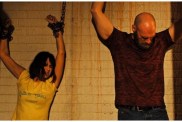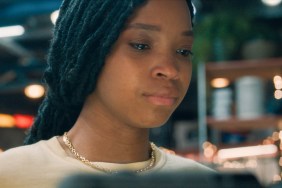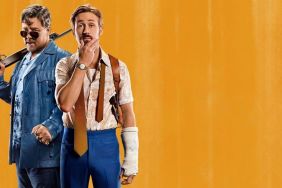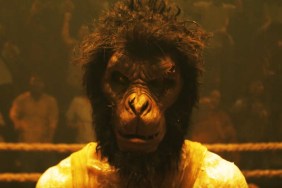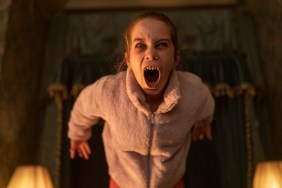ComingSoon.net has talked to Richard Taylor a few times during the publicity process for The Chronicles of Narnia: The Lion, The Witch and The Wardrobe, most notably at Comic-Con International in 2005 where Taylor was treated like a rock star by the masses, who were fans of the work he and Weta Workshops had done on Peter Jackson’s “The Lord of the Rings” movies. Having won five Academy Awards, Taylor had even bigger miniatures and models to build for the sequel and a lot more armor and weaponry to design in order to suit up literally hundreds of extras playing the Telmarine army. Taylor was visiting the Usti sets with his family, more of a vacation from the work he’d been doing down in New Zealand, but he took some time to sit down with us and tell us what he’s been up to.
ComingSoon.net: So you’ve been involved in this movie doing the miniatures?
Taylor: We’re doing some costuming work, weapons, armor, and miniatures. There are going to be a mess of miniatures. We coined that phrase “bigatures” on “The Lord of the Rings” and this is going to outdo them all. The miniature we’re doing for Miraz’s castle is 24-scale, village, and exterior location at 100th scale and both miniatures are bigger than this tent. They are colossal things.
CS: Are you more involved with this movie than with the first movie?
Taylor: We’re about the same amount. On the first one, we played a much bigger part in the creature design but because Howard [Berger] did the creature suits for this one, it was just a natural progression for Howard to continue on and do all of the creature work from the beginning. That’s been wonderful. Howard’s my closest friend and we collaborate and write across the world, sending each other emails to see how each other is doing. It’s been great watching his stuff and our stuff develop together. A lot of the Telmarine armor got made up here in the Czech Republic, and they’ve done a beautiful job on that as well. It’s been cool.
CS: How have you been able to work on stuff down in New Zealand while Andrew and the rest of the production team are up here in Czechoslovakia?
Taylor: Just very good correspondence through Roger [Ford]’s art directors. We have a production team that daily coordinates with us. They’ve 3D modeled it. It’s amazing how the world has changed in the last five years for us all. He’s 3D digitally modeled the castle, we get that data, we put that through our 3D milling machines and our 3D printers, we print pieces and mill pieces. We’ve had to custom build some machines to actually manufacture the coarse lines in the miniature and so on. It’s been quite a mission. It’s the same with the swords as well. We had two and a half months to deliver two and a half thousand weapons, so as in the previous film we couldn’t hand grind the weapons. We actually purchased a very large 3D milling machine and digitally milled all the blades out, running 24 hours a day, seven days a week to actually get all of the saw blades made in time and then cast urethane hilts onto them all.
CS: Have you seen the castle yet?
Taylor: No, I see it tomorrow. We’re building off of photographs and I don’t think I’ve ever seen anything like it from the photographs so I can’t wait to see it. It’s very odd being a miniature builder because you myopically focus on things. Even if you’re building a miniature as big as this room, everything you build you build on a table at scale, you bring all of the pieces together and throw into a huge miniature and it’s going to be bizarre tomorrow, having focused on the colors and tomorrow I will be walking through it.
CS: What kind of material did you use to build the castle miniatures? (Note: You may want to be sitting down for this response.)
Taylor: The castle is such a geometric structure. It’s really interesting when you build a miniature because if you look at the world of architecture even in the medieval period, the only way it stands up is because it’s absolutely pure of form. If it in any way meanders, it cannot survive, so it’s structurally incredibly solid. When you scale down, if you move that structure by even one millimeter at 24th scale, the whole thing looks like it’s wrong. What we did was took the digital data from Roger’s department and we used that to drive computer controlled hot wiring machines that cut all of the castle tower blocks out of massive pieces of polystyrene, some of which were 5 meters tall by 2 meters across. Then we invented a machine, we took a cylinder of aluminum and we used a 3D milling machine to engrave and index a brick texture at 24th scale that exactly matches the 1:1 scale around the cylinder and then we built a lithographic printing press. When you turn the handle, it feels continual sheets of 25mill pieces of urethane through the machine and out the end you get these sheets of exact 24th scale brickwork. Then you very carefully wallpaper and then you get into all of the complex detail. We used a huge amount of 3D printing which is the technique of feeding digital data into a machine. It zips backwards and forwards and prints a three-dimensional plastic. When you melt away the support material, it will be the exact object. All the incredibly elaborate carvings around the door and so on has all been 3D modeled and 3D printed. We’ve used an awful lot of 3D milling technology as well to cut all of the coarse lines, all the staircases. We built the miniature of Minis Tirith, which had a thousand buildings in it. It doesn’t come close to the difficulty in replicating Roger’s full-size castle. It is so exciting and so challenging and on a monumental scale. I can’t wait to get it in front of the camera. We’ve very fortunate that directors like Andrew still celebrate in the tradition of model-making because so many modern filmmakers are moving firmly toward digital technology as the only solution, but there’s a hundred years of history that has allowed us to get this place in filmmaking and why wouldn’t you continue to pay homage to all those techniques. Thankfully when Andrew came to these two environments, he determined that they would be built as miniatures. We consider ourselves to be extremely lucky right now.

CS: What sequences will they be used for?
Taylor: Any other shot other than the castle interior courtyard. So when the griffons are flying over, wide shots from the outside, shots flying over the walls, creatures attacking, riding across the bridge and through the town, through the trees up the sides will all be miniatures. We’re building a miniature, hundredth scale, of the castle the square of which is no bigger than this table, but it sits in a huge landscape with the rivers, the mountains, the faraway hills, the plains. The whole village is being built, the houses as big as this tape recorder, but there’s a thousand of them right down to the individually made tile roofs. It’s cool. It’s really cool.
CS: Since you’re building a lot of these models, can you talk about incorporating the computer-generated stuff in with them?
Taylor: The most incredible thing for a director such as Andrew or Peter or a James Cameron is that the toolbox, the repertoire of tools that exist today is so complimentary of the vision of the people that these people have. I’d like to think that there is nothing that the human mind can’t dream up now that can’t be actually realized onscreen for a sophisticated audience. A seven year old child is a highly sophisticated moviegoer today. Therefore, that complex interplay of traditional practical techniques that have existed for a hundred years has been not super ceded, but complimented by digital technology woven together into this almost evocative, spell-like visual, it’s an amazing medium. No one does it better than Andrew. We’ve just watched 15 minutes of cut together footage and you just know that he is emoting with this complex interplay of live action, digital effects, miniatures, practical, traditional .. every possible tool out of that box is brought to bear to create this world. Wow. It’s just fantastic.
CS: At this point in your experience, with The Lord of the Rings movies and the first Narnia movie under your belt, is this an even bigger scope?
Taylor: Big is an interesting one. The miniatures, although there are not a huge number of them, are the biggest and most challenging ones we’ve built to date and we’ve built some pretty challenging miniatures. On “Kong,” we built 54 miniatures over that year but these miniatures are very challenging on a technical level. We’ve pushed ourselves further than we ever have before with our weaponry. For Miraz’s weapons, we actually used 3D modeling technology, then printed them in wax, and used casting processes to actually manufacture the ornateness of the weapon. We just didn’t have the skills to do that incredibly delicate filigree in any other way. It’s been really wonderful to challenge ourselves to meet Andrew’s expectations. We knew going into the movie that he’d want to step it up to a whole other level and it’s been really exciting being asked to do that. Miraz’s armor, they cast the actor very late in the piece so we’ve been holding off, waiting to find out who the actor would be. Once the button got pushed and we could start making it, we’ve been able to turn around this very elaborate armor and get it on set it time. It’s been wonderfully challenging, a great experience.
CS: Can you talk about the design motifs used in Miraz’s weaponry?
Taylor: Like the first movie, it’s really interesting because C.S. Lewis’ world expands well beyond the literature that we know as the books of course. He drew considerably on a broad range of mythology, Grecian mythology primarily, but going forward into Prince Caspian he continued to do that. Therefore what we try and do is hang the visual motifs, the armor or the weaponry or the filigree, onto certain mythological visual images. We’ve played a great deal with the creeping ivy. This is a Kingless state, this is a steward that has taken hold of the land and he has promoted himself into this position, so we tried to create a visual analogy of the way that his tendrils of control have infiltrated all levels or power, government, and politics throughout the Telmarine society. We wound that through his armor, as if it’s ivy climbing over plants and strangling them. That’s how we tried to evoke that feel, but also he’s filled with incredible arrogance and pomp. Even though his armies are regal and resplendent in their armor, he still has almost taken on an almost overtly decorative quality because of his armor trying to give him grandeur. When he sheds his armor he may be quite a frail man underneath, but when he puts it on he can build up this huge personality and then he creates the idea of Andrew’s that all of his commanders can be thrown into these faceless guises by putting on these masks. It’s an absolute counterpoint to the Narnians. The Narnians are these almost feral animals now, all about their emotions, where the humans guard their emotions and hide themselves under these masks. I hope that it’s successful in evoking a world in intense contrast, the world has moved on 1200 or 1300 years since we were last in Narnia and you want to give that feeling of a world in incredible turmoil.
CS: Why is it so important to get such a level of detail on the costumes and weapons?
Taylor: I guess that’s a good debate. People often come to the workshop as ask us why we are being so fanatical, but the real world is a cluttered world. It’s cluttered with history and detail and a culture. Just walking around the city of Prague, it’s saturated with details and it shows a lineage and history, which dates back hundreds if not thousands of years. That’s my feeling with proppage, weapons and armor. If it doesn’t have that depth of detail, you can’t help to suggest that the world exists outside of the picture frame. If it’s a shallow visual image, it suggests that you are watching a film, but if it has a level of saturation and detail it suggests that there’s a history there that spans around the world that sort of can book end it, that exists beyond the movie.

CS: Can you talk about the decision in this film to use Shane in the suit as Aslan, rather than using a tennis ball reference like in the first film?
Taylor: I can’t talk to that character because I don’t know enough about that, but I think it’s fair to say, like all these things, that everyone learns. This group of filmmakers has learned some tricks from the first film, things that wouldn’t do again because it caused great pain and difficulty in post-production and then they’ve learned very sophisticated things which have really helped and allowed them to build a richer and broader world at a visual level. I think any of these techniques, I can’t speak to the specifics because I am not sure myself, but that’s why they’ll be challenging themselves
they’re fresh with it. I appreciate the level of things like hip replacement they’re doing. This is really advanced stuff. They’ve got a handheld free moving camera with a moving creature and they are digitally locking these things together from multiple points throughout the castle. This is evoking an incredibly exciting visual world that an audience will just be blown away by. I can’t wait to see it! Even appreciating a small amount of what it takes to get it on the screen makes you realize that this is mastery at a film level that arguably may never have been seen before. That’s really phenomenal.
CS: Is there anything that made you sweat on this movie?Taylor: Yes, there have been a number of things actually, time being the great challenge. We understand that you can never push back on time, you understand that the whole thing is a complex process of interlaying of actors and writing and design. The thing has to build a momentum before it comes to a conclusion that you can start building from and we want to be respectful of that, even though we’ve been putting our hands up squealing a little bit saying, “Let us get going!” (Laughs) There is nothing you can do about it. You just make sure that the crew are ready to go when the button gets pushed. We would like to think that we’ve become capable of turning on a dime to get a lot a stuff done very quickly, so we’ve managed to produce a lot in a very short time for this one. That’s been incredibly exciting in the workshop, there’s nothing like that momentum and that feeling of productivity. You know we were shipping half a ton of product every two weeks out the door.
CS: Do you have a favorite prop in this film?
Taylor: Yes. It’s funny when we’re making props because you do fall in love with them. My favorite prop is Miraz’s buckler, the round shield fought with by Miraz. I’ve actually gone and manufactured one of my own and it sits in my office right now. I think it’s one of the most beautiful things that our crew have ever made. I was very proud of the design, it was designed by a young guy who is incredibly talented young chap who joined up at the tail end of “The Lion, The Witch and The Wardrobe.” We’ve enjoyed doing all of the Miraz stuff but this one buckler was just perfectly balanced, it’s just a beautiful piece of weaponry. We’ve had to develop a lot of new techniques, things like the horse plates, they look quite simple but Andrew wanted a spike out of the front of them. Now you need a firm faceplate that won’t flop and wobble around otherwise it won’t look like steel, but if the horses hit you run the risk of having this rigid object jamming into the flank of another horse so we’ve developed a way where we can actually blend different densities of urethane to inject through a low-pressure injection molding gun so that the spike is soft and the faceplate is hard. It’s been really neat trying to come up with these technical chemical solutions for a fantasy/medieval movie.
CS: When you’re done with the stuff, is it recycled?
Taylor: No, they all go into very careful storage. We actually archive them and then put them into shipping containers and then put into a massive storeroom we hold. When they came to shoot the second movie, we were able to pull it all out again, it was good to go. They were able to literally use the little bits they wanted to use again if they needed. We would never use it on another film because of the purity of the project but if there is a continuity of the films such as this
we were able to take some of the weapons and make them look antiquated as if they were put in the How, locked away, and 1300 years pulled out again. They are rusted and rotted, we did a huge amount of art department work to age them and break them down. It was a huge cost savings.
CS: It must be a huge space.
Taylor: When you think about the cost of the real estate, but these are artifacts. Some people would say they are film props but I don’t believe that. I think they are fine artifacts worthy of looking after with great care. Whatever the cost of storage and archiving, they need to be looked after. We’ve now got 21 years of product archived with the dream that one day it can be exhibited for the world to see.
CS: Are you involved in the next movie?
Taylor: Oh we hope so. We’ve actually just started on it. We’ve been doing about four weeks of design. We’ve met the director (Michael Apted) who is a lovely guy. We hope so. We’d love to be in this world for the rest of our lives if we could.

CS: It also keeps a consistency:
Taylor: You’ve got to respect the fact that the audience has bought into a journey that will span most of a child’s life. If you break the consistency, you’re breaking that world. A young child that entered this world on “The Lion, The Witch, and The Wardrobe” would be five or six years old. They are now 9 or 10, and by the time the third one comes out they’re going to be in their mid-teens. They are on this incredible journey with these children, and it’s very, very important that they grow with the kids and that the story stays consistent with the kids. I hope we get to work on them all ultimately.
CS: What kind of stuff have you had to design or work on?
Taylor: Because it’s that book, “The Dawn Treader,” it’s just that world really. It’s just in very early, very conceptual ideas.
CS: Do you guys have any sort of relationship with the ILM guys, whether it be competitive or comraderie?
Taylor: Not so much, other than we have benefited hugely from the inspirational work they do. I hope it will be the same in return. A lot of the people who work at Weta have come from ILM and vice versa. The digital world, our workshop stays very consistent, the practical side of our company, and our crew fluctuates very little. Weta Digital, the digital technicians of the world, move around a little bit to go and work on premium shows, so we’ve benefited hugely from the skills and abilities of the people from ILM as has every digital effects facility in the world. They are the cornerstone of our industry. They have done much of the work that has established what we know today.
CS: I was thinking specifically about Davy Jones and whether you think he may have been inspired by some of the stuff you guys did on “King Kong”?
Taylor: I don’t know about that there. That work is cutting edge, it’s as good as it’s ever been. It was truly the most beautiful. We were challenged with Kong because we had to evoke human emotion into a totally digital character at a level that hadn’t been achieved before but each time someone rolls on and does something so spectacular, as a moviegoer as we all are, it’s incredibly rewarding too for us to watch. I think sometimes you’re sitting in there for two a half hours, you’ve paid your twelve dollars, you actually don’t dwell on the fact that four or five hundred, one thousand, two thousand people’s endeavors have been poured into that three hours over two and half years. Just coming onto this set, it’s incredible. This is mobilizing of people power at an astounding level to entertain billions of people for three hours. That is a real treat that we all have been blessed with.
CS: Is there a genre you want to take a stab at that you haven’t worked in yet?
Taylor: Yeah, we’ve been buried in the medieval and primordial. I love this genre, fantasy. We are getting our fair share of high science fiction at the moment. We’re just finished a major horror movie and are doing another right now. We’ve just done “30 Days of Night” and working on “Daybreak” at the moment. No, if I were to do fantasy for the rest of my life, I would be a very happy person. Sci-Fi is an interesting medium. I like anything that gives us a challenge to build. I love children’s television, that’s where my personal heart is, that’s what we’re pursuing as our own venture.
CS: Do you ever think about stepping behind the camera for one of the movies since you have such a strong perspective on the world of Narnia?
Taylor: You mean directing? I had been offered some directing opportunities, a fairly significant one, but no I don’t have any interest. That’s not to undersell that opportunity, it was an incredible honor to be offered, but my heart is in the practical workshop work and anything that were to take me away from that as dumb as that may sound (laughs) is not a good say to be spent. I just love making this stuff. The morning that I left the workshop to fly out to come here, I had been working on shaping a huge castle, Miraz’s castle, and it’s so intriguing to me. We’ve been doing it for 21 years now and I’ve not found that I’ve ever abated in my interest. To take six months off away from making something to go and direct something wouldn’t appeal to me.
CS: Couldn’t that satisfy you more creatively?
Taylor: No, we are developing our own product, our own children’s television and our first shows out around the world and that gives me huge enjoyment, but as far as directing, no.
Back to “Prince Caspian” Set Visit Part 2 or read our interview with Dean Wright and Howard Berger where they talk about the effects of “Prince Caspian.”
